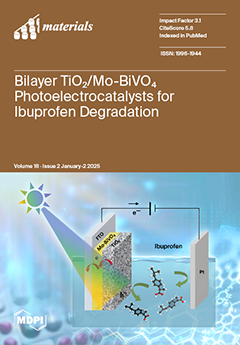Hydrogen embrittlement is a critical issue for zirconium alloys, which receives long-term attention in their applications. The formation of brittle hydrides facilitates crack initiation and propagation, thereby significantly reducing the material’s ductility. This study investigates the tensile properties and hydride morphology of a novel zirconium alloy under different hydrogen-charging current densities ranging from 0 to 300 mA/cm
2, aiming to clarify the influence of hydrides on the fracture behavior of the alloy. The mechanical property results reveal that, as the hydrogen-charging current density increases from 0 to 100 mA/cm
2, the maximal elongation decreases from 24.99% to 21.87%. When the current density is further increased from 100 mA/cm
2 to 200 mA/cm
2, the maximal elongation remains basically unchanged. However, a substantial drop in elongation is observed as the hydrogen-charging current density rises from 200 mA/cm
2 to 300 mA/cm
2, decreasing from 20.77% to 15.18%, which indicates a marked deterioration in hydrogen embrittlement resistance. Subsequently, phase compositions, fracture morphology, and hydride types in the fracture region of tensile specimens were characterized. The morphology and quantity of hydrides change with increasing hydrogen-charging current density. When the hydrogen-charging current density reaches 100 mA/cm
2, the δ-phase hydrides form, which significantly reduces the ductility of the zirconium alloy. At a hydrogen-charging current density of 200 mA/cm
2, metastable ζ-phase hydrides are formed, resulting in negligible variations in the alloy’s mechanical properties. However, when it comes to 300 mA/cm
2, stable δ-phase hydrides with diverse morphologies form, leading to a pronounced degradation in tensile performance. Finally, by integrating mechanical tests with microstructural characterization, the influence of hydrides formed under different hydrogen-charging current densities on the zirconium alloy was analyzed. With increasing hydrogen-charging current density, the maximal elongation of the specimens gradually decreases, while the tensile strength steadily increases. At a hydrogen-charging current density of 300 mA/cm
2, a larger amount of hydrides is formed, and the hydride type transitions completely from a mixture of δ-phase and ζ-phase hydrides to entirely δ-phase hydrides. The formation of lath-like δ-phase hydrides induces twinning structures, resulting in further lattice mismatch, which significantly reduces the maximal elongation of the zirconium alloy. Additionally, the morphology of the δ-phase hydrides changes from slender needle-like structures to lath-like structures, leading to a notable increase in internal stress, which in turn further enhances the tensile strength of the specimens.
Full article






